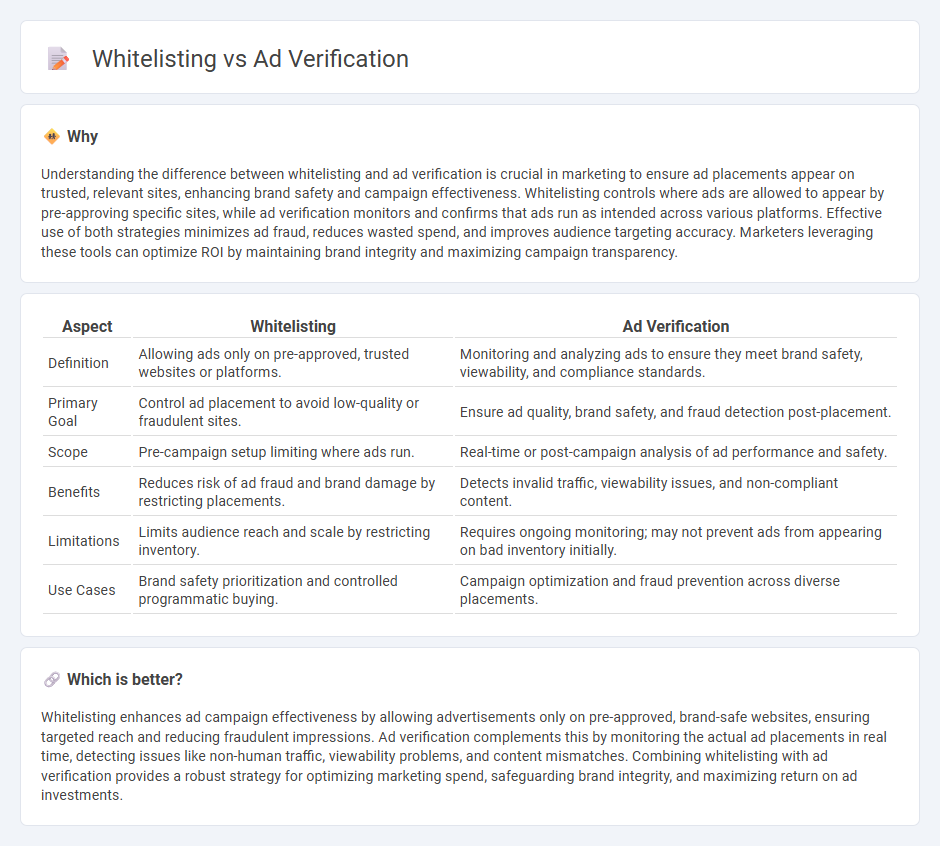
Whitelisting in marketing involves pre-approving specific websites or platforms where ads are allowed to appear, ensuring brand safety and targeting accuracy. Ad verification technology monitors and validates ad placements in real-time, preventing fraud and ensuring compliance with campaign standards. Explore more to understand how these strategies can protect your brand and maximize ad performance.
Why it is important
Understanding the difference between whitelisting and ad verification is crucial in marketing to ensure ad placements appear on trusted, relevant sites, enhancing brand safety and campaign effectiveness. Whitelisting controls where ads are allowed to appear by pre-approving specific sites, while ad verification monitors and confirms that ads run as intended across various platforms. Effective use of both strategies minimizes ad fraud, reduces wasted spend, and improves audience targeting accuracy. Marketers leveraging these tools can optimize ROI by maintaining brand integrity and maximizing campaign transparency.
Comparison Table
| Aspect | Whitelisting | Ad Verification |
|---|---|---|
| Definition | Allowing ads only on pre-approved, trusted websites or platforms. | Monitoring and analyzing ads to ensure they meet brand safety, viewability, and compliance standards. |
| Primary Goal | Control ad placement to avoid low-quality or fraudulent sites. | Ensure ad quality, brand safety, and fraud detection post-placement. |
| Scope | Pre-campaign setup limiting where ads run. | Real-time or post-campaign analysis of ad performance and safety. |
| Benefits | Reduces risk of ad fraud and brand damage by restricting placements. | Detects invalid traffic, viewability issues, and non-compliant content. |
| Limitations | Limits audience reach and scale by restricting inventory. | Requires ongoing monitoring; may not prevent ads from appearing on bad inventory initially. |
| Use Cases | Brand safety prioritization and controlled programmatic buying. | Campaign optimization and fraud prevention across diverse placements. |
Which is better?
Whitelisting enhances ad campaign effectiveness by allowing advertisements only on pre-approved, brand-safe websites, ensuring targeted reach and reducing fraudulent impressions. Ad verification complements this by monitoring the actual ad placements in real time, detecting issues like non-human traffic, viewability problems, and content mismatches. Combining whitelisting with ad verification provides a robust strategy for optimizing marketing spend, safeguarding brand integrity, and maximizing return on ad investments.
Connection
Whitelisting ensures ads are displayed only on pre-approved, brand-safe websites, while ad verification monitors ad placements in real-time to confirm compliance with these standards. Together, they protect brand reputation by preventing ads from appearing alongside inappropriate or fraudulent content. This synergy enhances campaign effectiveness by ensuring visibility to the right audience within trusted environments.
Key Terms
Brand Safety
Ad verification ensures brand safety by continuously monitoring digital ads for fraud, viewability, and inappropriate content, preventing harmful placements that can damage brand reputation. Whitelisting enhances brand safety by allowing ads to run only on pre-approved, trusted websites, reducing exposure to risky environments. Explore effective strategies to combine ad verification and whitelisting for optimal brand protection.
Impression Quality
Ad verification ensures each impression meets brand safety, viewability, and fraud prevention standards by analyzing impressions in real-time to maintain high impression quality. Whitelisting restricts ad delivery only to pre-approved, trusted sites, boosting impression quality by preventing placements on low-quality or fraudulent platforms. Explore more to understand which strategy enhances your campaign's impression quality effectively.
Approved Inventory
Ad verification ensures that ads run only on approved inventory by scrutinizing websites and content for brand safety, fraud prevention, and compliance with campaign guidelines. Whitelisting involves creating a list of pre-approved websites or publishers where ads are guaranteed to appear, providing control and minimizing risk. Explore more about optimizing ad placement through advanced approved inventory strategies.
Source and External Links
What is Ad Verification and How does It Work? - Ad verification is a process that uses tags or beacons embedded in ad markup to confirm ads are displayed in the right context, protect against fraud, ensure viewability, brand safety, and geo-targeting, helping advertisers avoid fraudulent publishers and ad placements.
What is Ad Verification and How Does It Work? - Ad verification allows advertisers to verify ads are shown on appropriate sites and locations, using verification tags to check site content, ad placement, viewability, fraud, competitive separation, frequency caps, and geotargeting.
Mastering Ad Verification: Viewability, Ad Fraud, and Brand Safety - Ad verification ensures ads are delivered as intended by confirming viewability to real humans, protecting against ad fraud, and aligning ad placement with brand safety, providing advertisers critical insights to maximize ROI and maintain brand trust.
 dowidth.com
dowidth.com